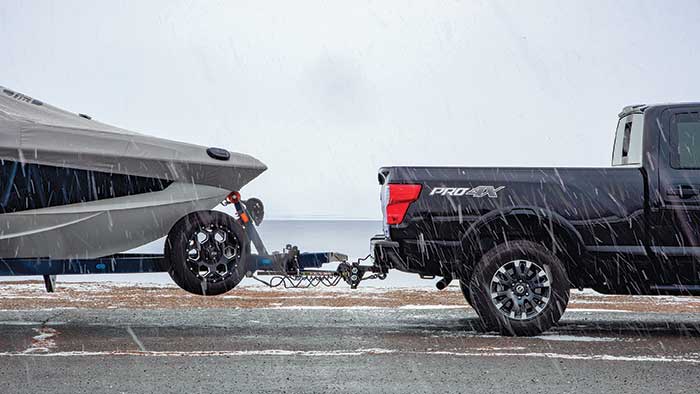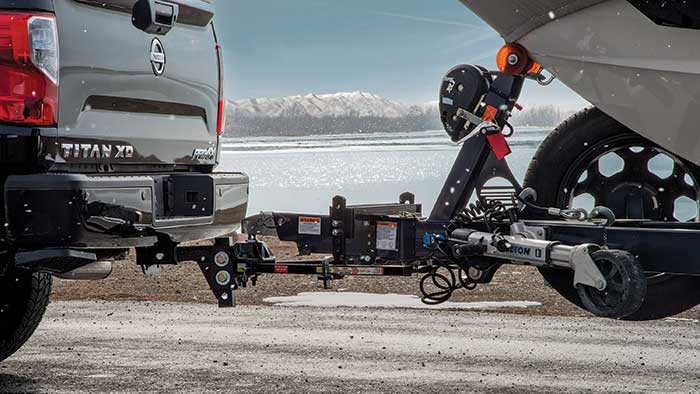Advertisement
These devices are often used for towing other types of trailers, but do they have any place when hauling boats?

Photo: Equal-i-zer
One beautiful August afternoon, "Joe" was cruising down the highway outside of San Francisco, headed home after a perfect summer day of fishing, with his boat and trailer in tow. Without warning, the boat trailer began to violently sway back and forth, also known as "fishtailing." Before Joe could react, the trailer tongue popped off the hitch, and the trailer — and boat — flipped onto its side, skidding into the vehicle. Thankfully, no one was injured, but not only did the boat hull have deep gouges from the impact and road rash, Joe reported damage to the tow vehicle, double-axle trailer, both 225-hp outboards, and his fishing rods. Even worse, his boating season ended abruptly.
While accidents that arise from fishtailing incidents don't rank anywhere near the top reasons for insurance claims, they do happen. A review of our GEICO | BoatUS insurance files turned up at least six occurrences in the last year, including Joe's. Some of these might have been caused by excessive speed, strong wind gusts, uneven roads, incorrect tire pressure, or passing trucks. But others, like this one, don't have any apparent causes. No matter why they happen, some likely could have been avoided with a fairly simple piece of equipment.
Holding Sway
Long popular with those who tow recreational vehicles, weight-distributing systems are a common feature on trailered campers, but not often seen on boat trailers. Weight-distributing devices use rigid torsion bars to more evenly distribute the weight of the load being towed and use chain or brackets to adjust and reduce the weight on the hitch and transfer it to the trailer axle(s). The combination raises the back of the tow vehicle and the front of the trailer so they're more even and there's less sag or "squatting" of the tow vehicle. When the weight has been properly distributed, and the entire tow vehicle and trailer are both sitting level from front to back, the result is smoother towing, decreased wear on the back axle and bearings of the tow vehicle, and better steering and brake control.

A combination sway-control and weight-distribution system makes sense for boaters trailering long distances, at high speeds, or in bad weather conditions. (Photo: Equal-i-zer)
The same goes for anti-sway bars. These devices are seeing more use among boaters who tow their watercraft atop a trailer. As trailerable-size boats get longer, larger, and heavier, it makes sense that the same benefits RV haulers have enjoyed from anti-sway hitches are being adopted by trailer boaters. Their job is to help curb the side-to-side movement of trailers being towed. Different systems achieve that in different ways. Here are five common anti-sway systems on the market:
- Friction sway control bars attach from the trailer frame to a small hitch ball on the trailer receiver or weight distributing system at the other end, providing tension to help keep the trailer in line. When the trailer begins to sway out of line, the friction pads inside the unit create resistance to limit side-to-side movement. The number of friction bars required depends on the trailer size and weight. For example, if your trailer has a gross tongue weight (GTW) of 6,000 pounds or less, a single friction-style sway control can be used. If the trailer's GTW is between 6,000 and 10,000 pounds, a two-point sway-control unit (one on each side of the trailer) is recommended. The downside of friction systems is that they're not compatible with surge or hydraulic trailer brakes, and the bars must be removed before backing up to prevent damage.
- Two-point sway controls are built into weight-distribution systems and include brackets on each side of the trailer frame. These serve as resting points for spring bars, and provide additional friction when the spring bars move forward, backward, or side to side along the brackets, limiting their movement and that of the trailer. Two-point systems often rely on the downward force of the spring bars to apply steel-on-steel frictional resistance to the brackets, while others use friction pads, which offer automotive brake-pad-like friction. Of interest to boaters, trailers equipped with two-point systems can back up without disengaging and can be used with surge or hydraulic trailer brakes.
- Four-point sway control systems are also built into a weight-distribution hitch and feature two brackets on the trailer frame that work like the two-point assembly, but with the addition of another connection point at the head where the spring bars are secured in place for optimum tension applied throughout the system. The four-point option offers additional control compared to two-point or friction-style systems. The trailer can back up without disengaging the system and can be used with hydraulic or surge brakes.
- Electronic anti-sway systems can be used with or without a weight distribution device and operate by activating the trailer brakes based on the trailer's speed and amount of sway. As such, the control is proactive, prohibiting sway before it starts. Electric systems can offer more anti-sway control than friction systems but are not compatible with hydraulic or surge brakes.
- Dual-cam anti-sway devices are designed for heavy loads, and rely on spring bars with curved ends resting over cams and stabilizers to offer a proactive system. If the spring bars move, they're forced to shift back into place and eliminate sway. Dual-cam systems provide more control than other anti-sway setups and allow the trailer to be backed up without disengaging, but are not compatible with surge or hydraulic brakes.
Don't Just Rely On The Tow Vehicle
Some vehicle manufacturers use a program often called Trailer Stability Assist (TSA) to help control trailer sway using sensors and the vehicle's computer. When the vehicle senses trailer sway, the TSA system engages automatically and uses braking to stop the sway. Most aren't compatible with surge-type trailer brakes, however, and will work only with electric and electric-over-hydraulic trailer braking setups. Another issue is that they don't react until sway has already begun and is detected, by which time trailer handling can have been compromised. TSA helps when towing smaller boat trailers. But for heavy trailers, sway-control bars and weight-distribution hitches are recommended.
Boat Trailer Challenges
Trailered boats can present particular problems with regard to weight distribution and sway potential. A powerboat, for example, will almost always be rear-heavy, due to the weight of the motor(s) and the fuel often being concentrated aft of the axles. Boat trailers also usually have a single-pole tongue, as opposed to an A-frame, which can require a pole tongue adapter to permit installation of a combination weight-distribution/anti sway hitch. Also, most weight-distribution hitches allow the trailer to be backed into place without having to be taken off, which is important when launching and retrieving a boat. Not so with friction-style, however. Sway-control systems that can bind when backing into tight turns should be disengaged before reversing and tight maneuvering.
While you can purchase separate sway control and weight distribution systems for both boat trailers and RVs, most trailer-towers opt for a combination system that offers the benefits of both features. If you've ever experienced a white-knuckle episode of fishtailing while underway when the weight is too far back, or loss of steering control when too much of the trailer's load is placed on the hitch, you can relate to the benefits of both options.
Advertisement
One Possible Solution
The only combination weight-distributing/anti-sway system we've found that can be used on trailers with surge brakes — the most common setup on boat trailers — is the Original Equal-i-zer Sway Control Hitch (starts at $687.95). Because of the hitch design and how its brackets allow for movement of weight distribution bars back and forth, the surge brakes are able to function properly without any issues. This isn't true for other weight-distribution/sway-control systems, which restrict movement and bind the surge brakes.
According to Equal-i-zer account manager Deven McCann, the device can be used on just about any boat trailer setup, but combination systems aren't as popular among trailer boaters as they are RV owners because in the RV industry, they're "more widely known and recommended." In fact, McCann says, most RV dealerships won't allow customers to take ownership of an RV without a weight-distribution/sway-control hitch. "It hasn't traditionally been a part of the discussion in the boat industry, unless a boat customer happens to also have an RV and knows how big of a difference weight-distribution and sway-control can make for the towing experience."
As mentioned, the biggest difference between RVs and boat trailers is the frame. McCann explains that most RVs have an A-frame, while boats have a single-pole or Y-frame design. "All of the Equal-i-zer hitches used for RVs are the same ones used on boat trailers. If your boat trailer is a single-pole frame or a Y-frame design, all of the same components are used, but they're arranged slightly different on the frame." The company offers an adapter for the single-pole style to make the install even easier. The system "provides drivers the ability to back up, turn, jackknife, hook up from any angle, use in and out of water, and works with surge brakes."
So, is a weight-distribution/anti-sway device right for your rig? If you're pulling a small fishing boat down to the lake a mile away, you probably don't need to worry about a weight-distribution/sway-control hitch. "However," says McCann, "if you're heading somewhere that requires high-speed driving, canyon roads, possible bad weather conditions, or long distances, then the extra safety, security, and peace of mind that a weight-distribution/sway-control hitch provides can be the difference between a memorable trip or one you hope to forget."
